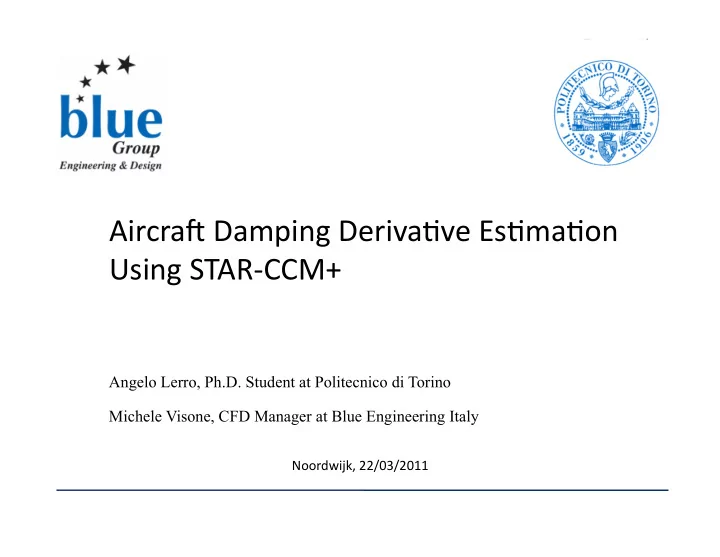

Aircra& Damping Deriva/ve Es/ma/on Using STAR‐CCM+ Angelo Lerro, Ph.D. Student at Politecnico di Torino Michele Visone, CFD Manager at Blue Engineering Italy Noordwijk, 22/03/2011
Summary Introduc/on Maneuvers • The Looping Simula/on • Theory Background • CFD Computa/on 2D Results Pitching Meneuver • Plunging Meneuver • Flapping Meneuver • • Looping Meneuver using MRF UAV Applica/on Mesh Details and Performance • CFD Computa/on • Results • Conclusion 22/03/2011 Aircra& Damping Deriva/ves Es/ma/on using STAR‐CCM+ 1
Introduc.on Coefficients are usually linearized and expressed as follows 1 There are unstedy and steady terms To evaluate the exact value of damping deriva/ves of Eq. 1 the following maneuvers are usually used Plunging Mo/on for deriva/ves Flapping/Looping Mo/on for deriva/ves Some wind tunnels are provided with special devices to perform unsteady maneuvers. 22/03/2011 Aircra& Damping Deriva/ves Es/ma/on using STAR‐CCM+ 2
Introduc.on ‐ Maneuvers All maneuvers performed are oscillatory mo/on, and so they depend on frequency PITCHING MOTION PLUNGING MOTION FLAPPING MOTION Under the linearity hypothesis, the flapping mo/on can be obtained with superposi/on of pitching and plunging mo/on, as follows _ = PLUNGING MOTION PITCHING MOTION FLAPPING MOTION 22/03/2011 Aircra& Damping Deriva/ves Es/ma/on using STAR‐CCM+ 3
Introduc.on ‐ The Looping Simula.on The steady state looping maneuver can be obtained with Whirling Arm Curling Test Section The looping deriva/ves are usually es/mated using the Usaf DATCOM, but it is not very suitable for unconven/onal aircra& such modern UAVs 22/03/2011 Aircra& Damping Deriva/ves Es/ma/on using STAR‐CCM+ 4
Introduc.on – Theory background Under the hypothesis of poten/al flow, Theodorsen developed a compact expression for the li& and momentum coefficients for oscilla/ng airfoils Theodorsen 22/03/2011 Aircra& Damping Deriva/ves Es/ma/on using STAR‐CCM+ 5
CFD Computa.on (1/2) We want a reliable and cost-limited method to evaluate the dynamic derivatives using STAR-CCM+ Main target: No-remeshing, deformable mesh, sliding mesh, and so on… Time-saving technique The NACA 0012 airfoil is used to validate the new methodology Second order time discretization Re = 3e6 Spalart-Allmaras Turbulence Model 22/03/2011 Aircra& Damping Deriva/ves Es/ma/on using STAR‐CCM+ 6
CFD Computa.on (2/2) The Computa/onal Domain for Oscillatory Mo/ons is the same used for steady‐state performance: you don’t need any par/cular mesh (deforming, sliding, and so on) The mo/on is imposed by Rigid Body Mo/on and Moving Reference Frame technique applied to the whole grid. Velocity Inlet Pressure Outlet RBM MRF 22/03/2011 Aircra& Damping Deriva/ves Es/ma/on using STAR‐CCM+ 7
2D Results – Pitching Menuver (1/2) f = 10Hz; α max = 5deg Theodorsen STAR-CCM+ While the airfoil is pitching an unsteady wake is generated downstream The aerodynamic response is oscilla/ng itself 22/03/2011 Aircra& Damping Deriva/ves Es/ma/on using STAR‐CCM+ 8
2D Results – Pitching Menuver (2/2) There is a very good agreement with Theodorsen theory With analy/cal manipula/on it is easy to obtain the value of deriva/ves STAR‐CCM+ is able to calculate with great accuracy the dynamic deriva/ves over a wide range of frequency 22/03/2011 Aircra& Damping Deriva/ves Es/ma/on using STAR‐CCM+ 9
2D Results – Plunging Menuver f = 10Hz; α max,induced = 5deg Theodorsen STAR-CCM+ 22/03/2011 Aircra& Damping Deriva/ves Es/ma/on using STAR‐CCM+ 10
2D Results – Flapping Menuver (1/2) Theodorsen STAR-CCM+ Flapping simula/ons with: f = 10Hz α max = 0deg q max = 5.5rad/s 22/03/2011 Aircra& Damping Deriva/ves Es/ma/on using STAR‐CCM+ 11
2D Results – Flapping Menuver (2/2) Theodorsen flapping motion combined motion There is a very good agreement with Theodorsen theory STAR‐CCM+ is able to calculate with great accuracy the dynamic deriva/ves over a wide range of frequency In the range of linearity the flapping mo/on can also be obtained using a “combined mo/on” of pure pitching and plunging mo/on 22/03/2011 Aircra& Damping Deriva/ves Es/ma/on using STAR‐CCM+ 12
2D Results – Looping Menuver using MRF R = 20, q = 2.5rad/s R = 100, q = 0.5rad/s Looping maneuver with different values of radius and q and the same velocity at the quarter of chord (V=50m/s) There is a quite perfect agreement between analy/cal data from Theodorsen theory and numerical results of STAR‐CCM+ simula/ons 22/03/2011 Aircra& Damping Deriva/ves Es/ma/on using STAR‐CCM+ 13
UAV Applica.on Performance Double-hull configuration* Static Stability Dynamic Stability The dynamic deriva/ves are extremely important to set up aicra& models In this presenta/on the looping maneuvers will be showed The q‐deriva/ves evalua/on will be presented *property of Nautilus s.p.a 22/03/2011 Aircra& Damping Deriva/ves Es/ma/on using STAR‐CCM+ 14
UAV Applica.on – Mesh Details and Performance ~ 4E6 polyhedral cells Sta/c performance and sta/c stability have been evaluated 22/03/2011 Aircra& Damping Deriva/ves Es/ma/on using STAR‐CCM+ 15
UAV Applica.on – CFD Computa.on Looping Maneuver Descrip/on TEST CASES V q (0,0,0) X R q X b = X w a = 0; b = 0 X b Y b Z b = X w Y w Z w V V Z b = Z w Z Aircra& Damping Deriva/ves Es/ma/on using STAR‐CCM+ 16 22/03/2011
UAV applica.on – Results RBM (R=60m, q=0.13rad/s) MRF (R=40m, q=0.2rad/s) Steady state looping maneuver The two methods are perfectly equivalent (max devia/on less than 10%) 22/03/2011 Aircra& Damping Deriva/ves Es/ma/on using STAR‐CCM+ 17
Conclusions STAR‐CCM+ helps us to simulate the unsteady maneuvers with an almost perfect agreement with the analy/cal results of Theodorsen theory; This allows us to validate the CFD technique used to es/mate both unsteady dynamic deriva/ves and steady‐state dynamic deriva/ves; Complete analysis of any aircra& can be carried out in order to set up a non‐ linear model ANY QUESTIONS? 22/03/2011 Aircra& Damping Deriva/ves Es/ma/on using STAR‐CCM+ 18
Recommend
More recommend